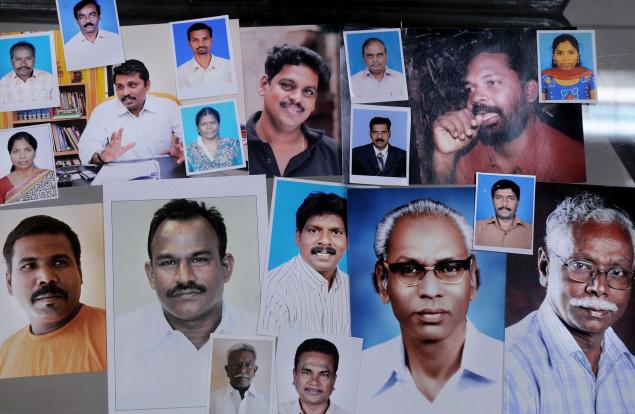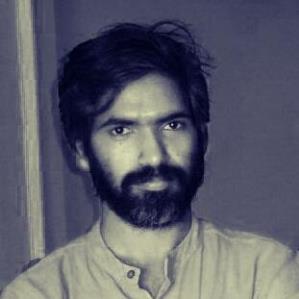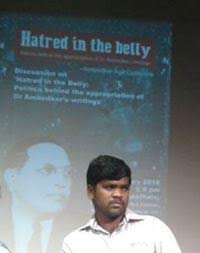Comments on Oxford India Anthology of Tamil Dalit Writing (Part I)
P. Dayanandan
(Paper presented on 10th April, 2012 on the occasion of the release of the Oxford India Anthology of Tamil Dalit Writing)

• I congratulate Ravikumar, Azhagarsan and Mini for bringing Dalit thoughts to English language readers at large. A quick look at Ravi’s writing, speaking and publishing record gives you some inkling of how Iyothee Thass must have managed his time to accomplish all his outpourings. Many folks gathered here, from the writing and publishing professions, defy time. I am grateful to all of you for this honor to receive a copy of the Anthology containing your precious writings, and make some observations on them.
• If we spend 3 minutes on each of the 78 selections it will take 4 hours. How then can we do justice to the 41 authors, translators, editors and the publisher? I will not attempt that. Neither will we discuss, at this stage, about the selection of themes nor authors, nor quality of translation and editing. I will not discuss if the segments selected from the books truly represent the whole. Plenty of that will follow as reviewers examine this Anthology.
• None can deny the importance of making available Dalit writings for current and future use. This Anthology will remain a major contribution in this growing field of publication of Dalit literature by Dalits including archival material and translations.
• I am quite happy if students of literature, say at the University of Wisconsin enjoy, critique and write term papers on Dalit poems, novels and fictions in this Anthology. If I were one of them I might say ‘what wonderful poetry!’ And I would take it for granted that human beings can write wonderful poetry. No one there will say ‘Oh, I did not know Dalits can write such good poetry or novels?‘ After all for 236 years they have known through their Declaration of Independence the self-evident truths that all people are created equal and endowed with unalienable Rights. Unfortunately India is not Wisconsin, notwithstanding the guarantee of justice, liberty, equality and fraternity in our Constitution. I still really suffer from the 20-centuries of civilizational crime of caste prejudice, notwithstanding my nine years at University of Michigan. So what I look for in this Anthology is if it offers hope. Amidst all the challenging, crying, weeping, accusing, abusing, ridiculing, laughing, celebrating, and loving utterance is there a common focus, a thrust for liberation and empowerment? Ambedkar did not write the Annihilation of Caste as an academic exercise. Or for showing the world how smart and creative he was. I believe this Anthology does reflect such seriousness of purpose.
• In the ultimate analysis such writings are meant to correct anomalies so that people can enjoy freedom, establish relationships with fellow humans and explore what their shared destiny may be. For 2,000 years we have lost this opportunity. And if they could, some would love to prolong this absurdity for another thousand years or eternity. I will not ask if this Anthology will help give Dalits their daily bread – at Rs. 26 per day, but we have the right to explore in what ways it will give us freedom, dignity, happiness, or simply, life!
• In this Anthology we have several selections that are life-affirming. To take one example that I had reviewed some years ago, we have ‘Scar’ or ‘Vatu’, an autobiography by that master story-teller and prolific writer Prof. K. A. Gunasekaran. Scar is a universal story of love that keeps people together in the face of the worst onslaught on their very humanity. KAG reveals how Allah empowered Mariam Beevi and Mimoon Beevi to become loving periamma and auntie for this little Dalit boy. It is a story of many people, knit together in overflowing concern for each other, transcending caste and pouring affection to affirm life. Scar is not a story of a sobbing Dalit but of a triumphant Dalit, a symbol of dignity and humanity, telling the world that it is possible to bury caste! Selling neem seeds must have something to do with it? I too collected neem seeds to exchange for vadai. Later I conducted major research on where the neem plant stores its chemicals!
• L. Elayaperumal’s ‘The Flames of Summer’, ably translated by D. Venkataraman is a gem in this Anthology, and a must read. This is a story of one of the most courageous Dalit leaders who ever walked on Tamil soil, and lived a life so that others can have a life.
• Editors note here that there has not been much interest in writing autobiographies. The autobiography of 200 million Dalits are there for all to see everyday – in oppression, poverty, deprivation, insults, rape and murder. There seem to be no readers! And the National English TV channels so excited about all other justice issues in every corner of the earth are notoriously apathetic to such biographies.(The Hindu I believe, is an exception, and we have seen it in Mr. Viswanathan’s sensitive writings).
• I was six-years-old, making a car with tires made of palmyra fruits, assembling the car using poles stuck into cracked clay of a dried pond in a Dalit village. The closest I came to a car manufacturing entrepreneur was when I went to Michigan, close to Ford country. Now Ford has come close to my village. N. D. Rajkumar reminded me of my story. Looks like he cannot afford a Ford Figo car of the year 2011. Rajkumar says: ‘My son wants me to buy him a toy car; It’s shut inside a glass case; so I give him a play cart fashioned from palm fruit and twigs‘.
• The palmyra palm seems to have some special place in Dalit stories. Others have pointed out if Bama refers to karu as the germ or the spiny petioles of the palm leaves (kaurukku mattai) in her much acclaimed Karukku. I learned in 4th standard: Thempadu panaiyin thrial pazhuthu oruvithai, vanura ongi valam pera valarinum, orivarkirukka nizhalagate. This verse goes along with the equally well known ‘Thelliya aalin…’. Traditionally they are attributed to Adhiveerarama Pandian. And characteristically, Iyothee Thass Pandithar says this was a distortion of facts and that Narunthokai (which includes these verses) was in fact Avvaiyar‘s (Ambigai Amman) third chapter (Vetri Vendhan) along with Aathi Chuvadi and Kundraivendhan.
• My mother says we were palmyra dependent shanars native to the neighborhood of Thirukalikundram, but my bosom friends from Tinnevelly tell me I cannot be a shanar. So much for the palm tree whose entire phylogenetic affinity I can tell you as a botanist, but this tree taunts me of my own identity! Who am I?
• Listen to what S. Sukirtharani says about my identity in her Portrait of My Village: ‘The thick sulphurous smell, of the fermented gruel, received with palms cupped and raised – given as wages for grass cut, bundled, borne by hands abraded by ulundu plants – still pervade the body, like a ductless gland’. Only Sukirtharani can portray it so well and only Lakshmi Holmstrom can translate it so closely true to the original. Not far from Chennai is Gudiyam and Attrampakkam area, which has the largest collection of paleoliths south of the Himalayas. This is evidence that our ancestral species Homo heidelbergensis lived here nearly a million years ago. Our own Homo sapiens ancestors might have been living in this region for the past 50,000 years or so. I visited this place several years ago to collect paleoliths and saw palms cupped and raised and abraded hands that no one will touch or shake. Here is a picture of it, and that narrows down my own identity!
• This Anthology addresses several issues – origin of caste and untouchability, identity, rereading the past, protesting and challenging oppression, and exploring how education, politics, culture, land and other factors can help overcome degradation and oppression. I understand from friends abroad who have seen the OUP website that there already is great interest in this publication.
• If you should rush for another edition I would suggest that a selection or two be added on Christian writings. After all, even before Iyothee Thass focused on Buddhism tens of thousands of Dalits thought Christianity was their liberating force. Missionaries were providing education as a liberating force in remote Dalit hamlets; caring for them when everybody else abandoned them during famine or plague, stood by them in their fight to drape a decent upper garment over their women’s bodies, appealed to the government for various concessions, and were the primary players in obtaining Panchami lands. We would not have Thiruma and Sivakami’s articles on land in this Anthology but for Rev. Adam Pariah Andrew and Rev. William Goudie, working in Chengalpattu area and engaging Tremenheere and the government on these issues.
• There are also lessons that all oppressed people can learn from Christian writings since we have material available on liberation theologies developed by Dalits in Tamil Nadu as well as by Blacks, Minjung, Buraku and Sami and other oppressed people in South and Central Americas.
• Selection on Christianity should be included also because the church, its leaders and institutions should be critiqued by Dalits at large. The church is now failing the Dalits and other marginalized people for a variety of reasons including lack of focus on the liberating power and commandment of Christ, and pervasiveness of elitism, greed and rampant casteism.
• Let me give you an example. I chose that famous Samaritan young woman and morphed her into a Dalit woman, as an older sister of Jesus, to question why Church has not eliminated caste discrimination and illiteracy in India:
Genesis Chapter One
By the well of Jacob
There I sat down and wept
Next to the man who asked for water
“Tell me, cousin, Jesus
Neither a pariah in the beginning nor in caste
How did I become one half-way through?
And you still remain a Jew?”
He bent down and wrote something
On that despised Samarian sand
Look! He could read my mind
I remain illiterate
• The General Introduction in this book is a good summary and a starting point for students and scholars to debate and explore several unsolved problems and contentious issues. Ravi and Azhagarasan are struggling with questions that we all have asked and given up with frustration. Indeed it remains a mystery as to how scholars who could reconstruct our pre and proto-history, and can so easily reconstruct the history of our rulers with precise dating somehow cannot satisfactorily explain when untouchability and caste emerged in South India. How did 76 Dalit and 35 Tribal communities come into existence? Who and what power was responsible for this, and when did this happen?
.• We have not even solved the problem of etymology of the epithet used to describe one of the largest Dalit communities, Paraiyar. However, people have not hesitated to baptize dogs and kites with this honorific name only to be so cleverly manipulated by some media. We can now see why Iyothee Thass becomes so important in Dalit history. This brilliant scholar has given us an explanation that cannot be brushed aside as a fancy theory. The implications of his elucidation go beyond the question of the emergence of untouchability in Tamil country and identity of paraiyar, to the impact of Buddhism on the culture and morality of people to hegemonic religious feuds for ideological and economic supremacy.
• Before I take up the question of identity I wish to point out something that has been puzzling me, namely identifying prejudice in Tamil context.
• Caste is responsible for many inhuman creations, so well recorded by many, and continue to be recorded everyday. For one thing it tried its best in every generation to effectively block the participation of nearly 1/5th of India’s humanity from making significant contribution to many fields. It continues to do so even after Independence. Those who rejoice in the eternal sanctity of caste and the power and prestige it brings would not only prevent Dalits from participation, they would also cleverly deny them any identity, any humanity. They would ensure that Dalits are preoccupied with their own misery and anger so that they do not become a challenge to them.
• Dr. Krishnaswamy points out in this Anthology how the society has been split for 2,000 years. One group has been cruelly cheated and set apart to work from birth with no choices. For the other group religion, not money has become an easy investment for exploitation. No wonder Ambedkar wanted us to strike at the very religious foundation if anyone cares to annihilate caste.
• This very Anthology and the writings are in one sense a drain on the energy, creativity and dignity of a people who at this stage in the history of humanity should be engaged with explorations and pursuits that are in consonance with our time and place in civilizational history. Instead, we are made to spend time on Dalit literature or Dalit theology that reveals anger and pathos, pity and protest and helplessness and militancy. Thenmozhi starts her essay on ‘Power that Transcends‘ with the sentence ‘We can say, that virtually all our present-day problems are, in some sense, problems relating to power.’
• Very true. Power to control, power for economic gains and material comfort, and power for privileged positions all operate to fuel caste and untouchability. Perhaps oppression caused by some aspects of power can be controlled through agitations, politics, and legal means. But is it power that makes one not clean his own dry toilet and ask for a fellow human being to do it? Is it power that generates honor killing when a girl forgets caste and marries a Dalit? What is there in caste that makes my fellow Christians discriminate against me? We must go beyond power, hatred, jealousy, greed, elitism and religious ideologies of an enemy for which we do not even have a proper Tamil word!
To be continued.
~~~
Dr. P. Dayanandan, in his own words:
I retired as a professor and chairman of botany after teaching for 38 years. I have a Ph.D. from University of Michigan. I also post doctored for NASA. I have carried out many funded scientific projects and 10 Ph.D. scholars have studied with me. My interests range from all aspects of botany to Pallava art history, Tamil literature, Dalit issues, education, space biology and spending time with young people to explore social consequences of oppression and empowering them to pursue studies in India and abroad.
Ten years ago I helped organize a student and youth group called ‘THUDI‘ involved in educating, agitating and organizing.
[Picture courtesy: The Hindu, March 20, 2012]










